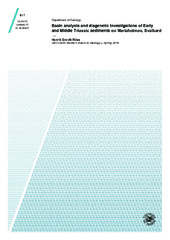Basin analysis and diagenetic investigations of Early and Middle Triassic sediments on Mariaholmen, Svalbard
Permanent lenke
https://hdl.handle.net/10037/15463Dato
2016-05-09Type
Master thesisMastergradsoppgave
Forfatter
Riise, Henrik ErevikSammendrag
Subsequent to a widespread hiatus at the top of the Permian on western Svalbard, the Triassic Vardebukta, Tvillingodden and Bravaisberget formations were deposited. In this thesis, the sedimentology, geochemistry and diagenesis are investigated to determine the depositional environment and basinal setting of the Triassic deposits.
In the investigated profile on Mariaholmen, only the upper part of the the Vardebukta Formation (from immediately below the Myalina layer) is exposed. The formation consists of interbedded sandstone and siltstone beds interpreted as sandy subtidal platform deposits. The lower Tvillingodden Formation consists of shale and siltstone interbedded with occasional sandstone beds, these deposits are interpreted as prograding prodelta clinoforms and bottomsets. The upper half of the Tvillingodden Formation represents a gradual transition to the Skilisen Bed and barrier tidal inlet lag deposits. The Bravaisberget Formation marks the transition from relatively shallow waters at the top of the Tvillingodden Formation to the onset of shale and siltstone deposits interpreted as prodelta clinoforms and bottomsets.
Five discrete sequences were recognised on Mariaholmen. All sequences were interpreted to represent either transgressive or regressive intervals of a prodelta environment situated next to a relatively large westerly delta. Within this environment river switching occurs in the westerly delta, and multiple hardgrounds and barrier structures are developed.
Trace fossil assemblages vary from proximal Cruziana ichnofacies to archetypal Cruziana ichnofacies. Trypanites ichnofacies is also recorded at the Skilisen Bed level. The trace fossil assemblages in conjunction with the sedimentological investigations limit the water depths to the interval from upper offshore to lower/middle shoreface.
Geochemical proxies such as TOC, TS, d13C_Org, V and Ni of the shales and shaly siltstones indicate a prevailing anoxic to dysoxic bottom-water conditions during deposition of the fine grained terrigenous deposits. However, oxygenated seawater is likely brought in frequently by flooding and storm events, which despite the oxygen-deficient bottom-water conditions during deposition of the fine-grained terrigenous sediments in the shale and siltstone allow for a thriving trace fossil fauna at the interface between fine and coarse grained beds and in the lower parts of decimetre thick beds. Discrete levels rich in nektonic ammonites in the shale also indicate that despite of anoxic to dysoxic bottom-water, the overlying water masses must have been oxygenated at these levels.
Acid dissolution of subordinate carbonate beds throughout the profile provided further information on the depositional environment, based on fauna and flora.
A diverse crinoid fauna indicates that the crinoids either recovered quicker, or that several clades possibly survived the Permian-Triassic extinction event in the northern Tethys.
A large d13C_Org excursion, which globally correlates with multiple localities, indicate that the Mariaholmen succession encompasses the Smithian.
Rock-Eval measurements of shales and siltstones show a predominance of kerogen type-III and type-IV, pointing to somewhat potentially gas-prone source rocks. Large-scale tectonic events in the Cenozoic and Mesozoic, and thick overburden prior to the Neogene erosion resulted in high burial temperatures, and as a result very little hydrocarbon potential remains within the sediments on Mariaholmen. The sediments are over-mature and pyrobitumen is found in diagenetic calcite and quartz veins.
Forlag
UiT Norges arktiske universitetUiT The Arctic University of Norway
Metadata
Vis full innførselSamlinger
Copyright 2016 The Author(s)
Følgende lisensfil er knyttet til denne innførselen:


 English
English norsk
norsk
